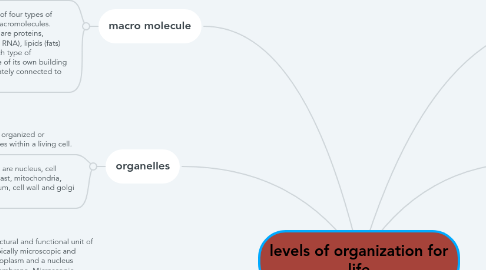levels of organization for life
by Isaac Hellard

1. macro molecule
1.1. a molecule containing a very large number of atoms, such as a protein, nucleic acid, or synthetic polymer.
1.2. Living things are made of four types of molecules, known as macromolecules. These macromolecules are proteins, nucleic acids (DNA and RNA), lipids (fats) and carbohydrates. Each type of macromolecule is made of its own building blocks, which are intricately connected to form different shapes.
2. organelles
2.1. any of a number of organized or specialized structures within a living cell.
2.2. The main organelles are nucleus, cell membrane, chloroplast, mitochondria, endoplasmic reticulum, cell wall and golgi apparatus.
3. cells
3.1. the smallest structural and functional unit of an organism, typically microscopic and consisting of cytoplasm and a nucleus enclosed in a membrane. Microscopic organisms typically consist of a single cell, which is either eukaryotic or prokaryotic.
3.2. Cells provide structure for the body, take in nutrients from food and carry out important functions.
4. organs
4.1. collections of tissues with similar functions.
4.2. Heart – Your heart is between the two lungs at the front of your chest. ... Lungs – your lungs are sponge-like organs. ... Liver – your liver is the organ below the lungs that acts like a filter for the blood. ... Kidneys – the kidneys are also filters.
5. atom
5.1. Atoms contain a dense nucleus surrounded by a cloud of electrons
5.2. The interior of the nucleus contains positively charged protons,
6. molecule
6.1. Molecules can have different shapes.
6.2. When atoms of different types of elements join together, they make molecules called compounds.
7. tissues
7.1. any of the distinct types of material of which animals or plants are made, consisting of specialized cells and their products.
7.2. There are four main types of tissue: muscle, epithelial, connective and nervous. Each is made of specialized cells that are grouped together according to structure and function. Muscle is found throughout the body and even includes organs such as the heart. Our outer layer of skin is epithelial tissue.
8. organ system
8.1. a group of organs that work together to perform one or more functions.
8.2. There are 11 major organ systems in the human body, which include the circulatory, respiratory, digestive, excretory, nervous and endocrine systems. The immune, integumentary, skeletal, muscle and reproductive systems are also part of the human body.


